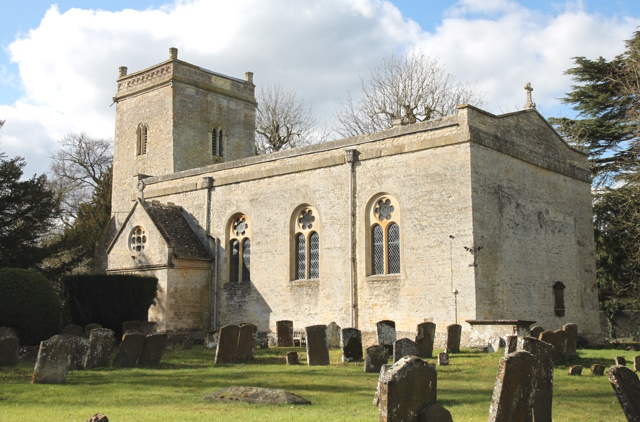


























The Church of the Blessed Virgin Mary, Weston-on-the-Green
Although in the 19th century there was a tradition in Weston-on-the-Green that the church had once been dedicated to St. Bartholomew, it is now known as The Church of the Blessed Virgin Mary. The present church is a plain rectangular building dating from the 18th century except for the western tower, which is probably 13th-century and belongs to an earlier medieval church. The tower has a later parapet and has been buttressed at the south-west corner. The original medieval church had three altars, dedicated by the bishop in 1273 to the Virgin, to St. James the Apostle, and to St. Nicholas the Confessor; twenty days' indulgence was granted to all those who gave to these altars. In 1564 the church, 'being in great decay', was reroofed and the seats were renewed. By 1741 it was falling down, and in 1743 and 1744 was rebuilt by Norreys Bertie whose initials and arms and the date 1743 can be seen on the rainwater heads. The present church has a pedimented south door, built in the classical style with an elaborately carved architrave and frieze on the outside; on the inside, stonework contemporary with the original building still surrounds it. The roundheaded windows, four on the north and three on the south side, of the 18th-century church remain. In 1810 extensive repairs were made to the roof, and the original heavily ornamented ceiling fell down and was replaced by the present plain one. The church was restored in the 1870's by the architect R. P. Spiers for about £500; a plan for building an apse 'to make the building more churchlike' was never executed, and the actual work only included repairs to the tower, the addition of the south porch, reseating, and the addition of Gothic tracery and glass to the windows. An organ was bought in 1885 and in 1923 the north and south walls were panelled. The 12th-century font is circular, with interlacing arcading on a moulded circular base of later date. Above the altar there is a large 18th-century canvas of the Ten Commandments surrounded by cherubs and symbols of the Crucifixion. Other decorations include a Russian triptych of the Virgin and two saints, the Assumption of the Virgin copied from an Italian original, and over the vestry arch an 18thcentury Royal Arms in raised and painted plaster. The church also contains a medieval iron cross, given by Lady Greville, and a plaster statue of the Virgin given in 1929. The iron gates at the eastern end of the churchyard were erected in 1951 as a war memorial. There are a number of monuments to the Norreys family, including those to Sir Francis Norreys (d. 1669); to Sir Edward Norreys (d. 1713), his wife Jane (d. 1722) and their children, to his second son Francis and his wife Jane; and to Norreys Bertie (d. 1766). There are also 19th-century memorials to the Bertie family. In the old church was a monument to Richard Chamberlaine (d. 1624/5), and a brass to Alise Saxeye (d. 1581). In 1552 the plate consisted of a silver and gilt chalice. In 1955 it included a silver chalice and paten cover of 1751, the gift of Mary Norreys. There were five bells, all 19th-century. Formerly there were three bells, dating from the 15th, 16th, and 17th centuries. The registers date from 1591, with a gap from 1672 to 1695. There is a churchwardens' book covering the years 1767 to 1917. Historical information about The Church of the Blessed Virgin Mary is provided by 'Parishes: Weston-on-the-Green', in A History of the County of Oxford: Volume 6, ed. Mary D Lobel (London, 1959), pp. 346-352. British History Online http://www.british-history.ac.uk/vch/oxon/vol6/pp346-352 [accessed 23 February 2023]. The Church of the Blessed Virgin Mary is a Grade II* listed building. For more information about the listing see CHURCH OF ST MARY, Weston-on-the-Green - 1233027 | Historic England. For more information about The Church of the Blessed Virgin Mary see Parishes: Weston-on-the-Green | British History Online (british-history.ac.uk). |

